Pawpaws (or papaws per Random House) can be among the most difficult wild fruits to find. They like to hide and woodland creatures like to eat them making it difficult for us. The easiest way to locate pawpaws is find them when they’re blossoming and they are blossoming locally now.
The most common place to spy pawpaws is and around pastures. Grazing livestock don’t eat the plants, blossoms or fruit. Look for bushy shrubs around five feet tall with magnolia-like cream-colored blossoms, or much smaller foot-size shrubs with dark ruby blossoms.
I can remember the first time I found a pawpaw. It was along a walking trail in Longwood, FL. At first I thought I had found a lumpy green pear but it was an unripe pawpaw. Interestingly pawpaws change greatly from hot Florida to the Smoky Mountain area. There, pawpaws are small trees.
There are two caveats: A chemical in pawpaws is still used to control head lice. And some people have a severe allergic reaction when eating them which is the prime reason they have not become a commercial fruit. That is, it’s not a significant health threat to the population at large but it is enough to give the lawyers fits. To read more about pawpaws, or papaws, click here.
?I am often asked: Can you eat grass. The simple question has a complex answer: Yes, no, maybe.
Strictly speaking we eat a lot of grass, but in the form of grain: Wheat, rice, rye, barley, millet et cetera. What most folks want to know is can you eat the culms and blades (stems and leaves.) What you just saw is also one of the impediments to learning about grasses, an argot all their own, a worse specific vocabulary than even mushrooms, and often identifying characteristics can only be seen with a dissecting microscope.
Humans are not multi-gastric (or in theory large-gutted). We aren’t designed to break down the cellulose in grass. Cows have a four-chambered stomach for that purpose, horses have a huge large intestine, even the gorilla has a gut that can accommodate large amounts of vegetation. We don’t. However, what we can do is dry the grass, grind it into a powder and use it as a bulking agent in food, such as breads, soups and stews. We don’t get much nutrition from grass prepared that way but it does add to the sensation of satiety and reduces hunger. Then there is the issue of cyanide.
I have read that all North American grasses are non-toxic. At the most basic level the means one has to know if the grass is native, which also requires identification, and I’ve already mentioned that group of plants can be a pain in the grass to identify. “Natives” would also include a lot species in the Andropogon family which I have never heard of having any use except perhaps making brooms. And some grasses have cyanide in them. Johnson Grass, a sorghum, is a good example. The large blades are full of it. Crowfoot Grass is another. We eat the grain of the latter but only after the plant has turned brown and the seeds are easily picked. Quite a few toxic grasses from Africa and Asia are naturalized in North America.
Personally I stick to a few grains, Sand Spurs, Barnyard Grass, and some Panicums. But then there is Timothy.
Permit me a reminisce: I recently bought another book for my foraging library, A Guide to Florida Grasses, by Walter Kingsley Taylor, not the first book in my collection from this august author. I will say more about the book in newsletters to come. I spent a wedding afternoon recently browsing through the guide and noted his entry on Timothy Grass. The picture alone erased more than 50 years and took me back to summers as a boy when I was impressed into service to harvest hay for our livestock, most of it Timothy, Phleum pratense, a grass originally from Europe. We “hayed” nearly ever summer for some 20 years, usually putting into the barn ten to 15 tons of loose hay. (There is some irony in that most of the hay we got every year came from the Hayward Farm.)
The main machine for cutting this hay was a horse-drawn sickle mower. Instead of two horses the tongue was extended four feet and was pulled by a stripped-down WWII Jeep, which I got to drive. As soon as I was old enough to reach the pedals I drove and Dad operated the mower. By the time I was legally old enough to get a driver license I had already driven thousands of miles in hayfields and across country roads. Most of my annual summer “vacation” was spent haying and driving.
The problems of haying became common. The cutter bar would break a tooth, a triangle-shaped replaceable cutting edge held on by rivets, which we replaced red hot from our own forge. At least once a season, more depending upon how thick the grass was, the piston arm would break, as it was intended to do. It was a piece of ash, called a pitman, that pushed the mower blade back and fourth being moved by gears turned by the wheels of the mower. When stresses got too much the wooden piston would break saving the rest of the machine from damage. Two other problems were common.
Often the cut hay would wrap around each of the Jeep’s drive shafts, build up like a wad of cotton candy, get hot and catch on fire, not far from the gas tank. This required quick stopping, crawling under the hot vehicle, putting out the fire, then removing the tightly wound hay, often, ironically, with a blow torch. The other issue, beside unpredicted rain, was ground hornets. The Jeep, pulling the mower, would run over a ground hornets’ nest — at least one per field. They were never pleased about that. The hornets would instantly swarm under the Jeep, then emerge between the back of the jeep and the mower where they would find both of us and attack. It was an excuse to change gears and drive like hell…
In places where the terrain was too wet or hilly my father, who was built like a heavy-weight boxer and did box, would take out a scythe and cut it by hand. He had two grim reaper scythes. One with a long thin blade for hay and one with a short thick blade for brush. Once the hay was cut and sun dried we would winnow it with a Jeep-adapted horse-drawn rake. Then it was loaded loose onto a hay wagon I would drive home. As the hay was lifted into the barn — a hay fork pulled by the Jeep which my mother drove — my job on those oh-so-hot summer nights was to go up in the high rafters of the barn with 100 pounds of salt for each ton of hay. As each forkful of hay was dumped into the barn I salted it to absorb any moisture thus preventing it from rotting, getting hot and starting a fire. And then… then throughout the winter I had to shovel and cart the recycled hay to the manure pile. No wonder I was a skinny kid.
And all the time — driving or shoveling — I had a stem of Timothy Grass in my mouth, chewing away enjoying the mild sweetness. It is a grass I would dry, powder, and use. Being a farm kid and chomping on Timothy was part of the same existence. It’s one grass that I know beyond any doubt. Timothy was unintentionally introduced to North America in 1711 by one John Herd. He called it “herd grass.” Clever. He talked it up and it was grown in southern Canada, New England area and New York. In 1720 a Timothy Hanson moved from New England to Baltimore and began to cultivate the seed and sell it. He was the first person in the new world who grew, bagged and sold hay seed. George Washington and Benjamin Franklin were admirers of the grass and Franklin is credited with calling it “Timothy Seed.” The name was shortened to Timothy and it stuck. It is found nearly everywhere in North America, and even in Greenland. I sometimes wonder what my youth would have been like — and adulthood — had Messers Herd, Hanson and Franklin not known good grass when they saw, ah, tasted it.
Recently added articles on EatTheWeeds.com: Sida, Wireweed; False Roselle; Edible Flowers: Part Eighteen; Gout Weed.
? Don’t even consider trying to eat the blossom of the Salvia coccinea, the Scarlet Sage. While it blossoms year round it is responding to the warm weather with wonderful displays of scarlet red blossoms. While they look like they would be wonderful additions to a salad they can put you in the hospital. The Scarlet Sage is one good reason why I am opposed to “field testing.”
One year I, too, thought the blossom might be a good salad edition. I researched the species extensively. It was a native, exported around the world for 400 years, had no reports of toxicity, had one medicinal report, and came from a good family, the sages. I decided to field test the plant, under very controlled conditions. That’s means I had researched the plant very well, knew exactly what I was doing, was NOT in an emergency situation, had good health insurance and a hospital nearby. Those are the only acceptable conditions, in my opinion, for “field testing.”
Thus I began the field testing in stages. On the appropriate day of the schedule I ate a piece of the red blossom that was 1/8 of an inch square, which as exact as I could get with my exacto blade and the delicate blossom. Forty minutes later my head spun and my stomach cramped and I was ill for three weeks. I was close to going-to-the-emergency room ill within the hour. By day two I was just sick. Pepto Bismo calmed the stomach and Coca-cola syrup (both from the pharmacy) controlled the nausea. For three weeks I consumed little but Pepto Bismo and Coca-cola syrup.
Imagine if I were not intentionally testing the plant under optimum conditions? What if it had been an emergency, and I was responsible for others, and I took it upon myself to “field test’ an unknown plant as, unfortunately, far too many “survival” books recommend. I would have been out of commission, useless, of no help to any one exactly when needed the most. And if you “field test” the wrong plant you could be more than just sick. The next time someone starts to teach you the “field testing” method ask one question: What plant do you eat now that you discovered by field testing? The answer is always “none.” Then ask: “have you actually ever field tested a plant?” The answer is usually “no.” A lot of folks are teaching something they have never done. I turned down a lucrative fee to go to a convention and teach “field testing.” I don’t think “field testing” should be done in the field. Just the opposite; if ever it should be done under very controlled conditions after a lot of research and with medical facilities near by. In other words, rarely, if ever. There is a picture of the non-edible Salvia cocinnea here. Let’s just say: Don’t go there.
Botany Builder #15: A Spike and a Raceme are similar inflorescences but they have a distinct difference. An inflorescence is a flowering system that has more than one blossom. A dandelion is NOT an inflorescence. A cherry blossom which has many flowers is an inflorescence. Both a Raceme and the Spike have multiple blossoms along a stem. However, the Raceme blossoms have short stems (petioles) that attach to the main stem. The wisteria has a Raceme. Blossoms on a spike attach to the main stem directly. They do not have short stems (petioles.) The common gladious is a spike, and a rather large one.
Its blossoms, left, attach to the main stem directly. The blossoms do not have short stems. Note on both the Raceme and the Spike older flowers are larger than the newer flowers which are near the end. Usually ripening of the fruit or seed on both also proceeds from nearest the plant towards the end away from the plant. Both glads and wisteria blossoms are edible. To read about glads click here, to read about wisteria click here.
Herbal Conference Reminder: Scheduled for the 23-25 of March, I will be there and many other teachers. Mention Eat The Weeds and you get a 20% discount. To register, or learn more, visit www.FloridaHerbalConference.org. There are benefits to being involved. March is a wonderful time for plants and people in Florida.
Upcoming Classes: Saturday, March 24, Jervey Gantt Recreation Complex, 2390 SE 36th Ave., Ocala, 9 a.m.
To donate to the Green Deane Newsletter click here.

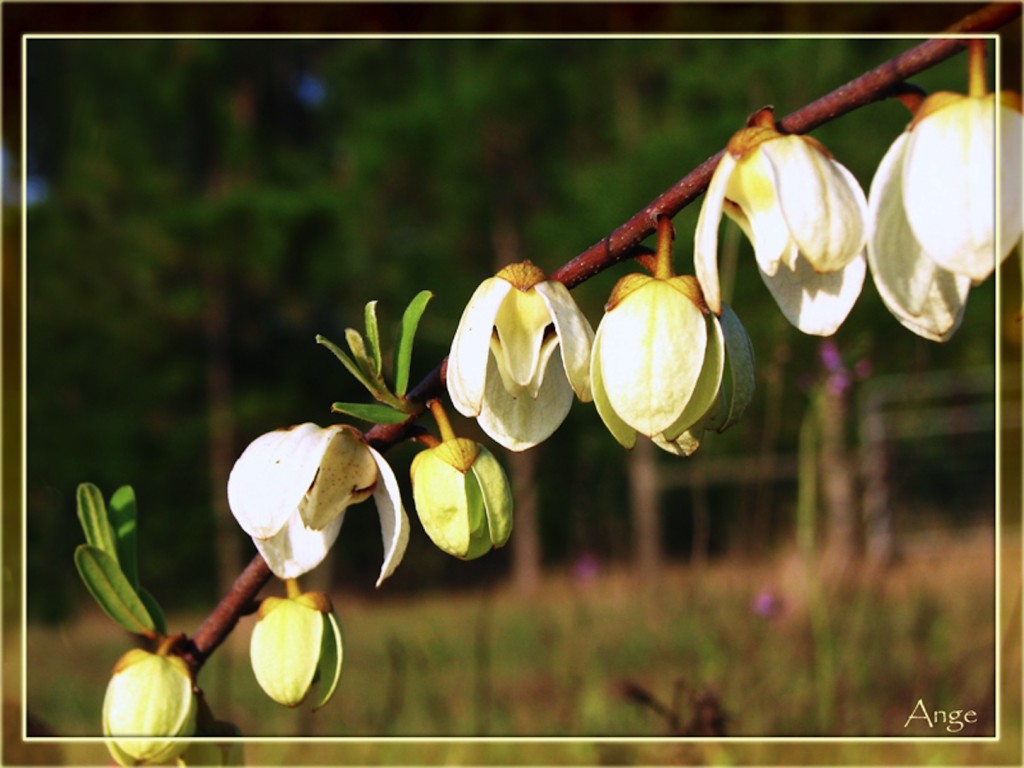
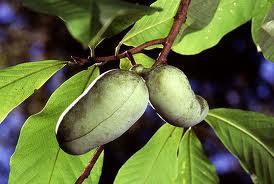
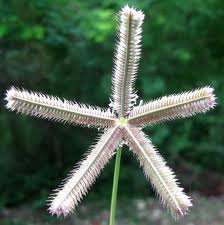
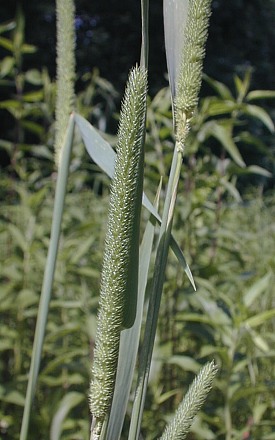
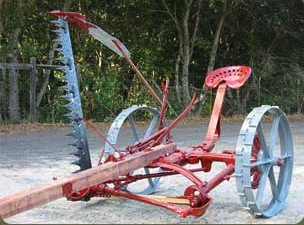
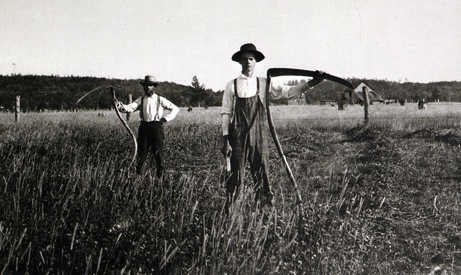

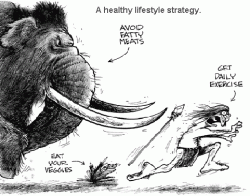
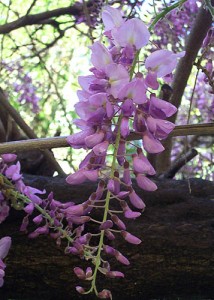
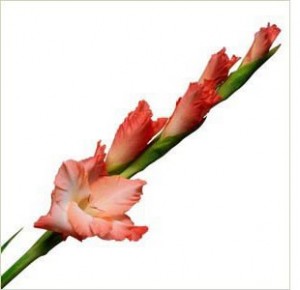

I saw a sicklebar cutter today next to a fence at the entrance of San Felasco Nursery. My son asked me what it was and I had no answer for him. Then I came home, read your newsletter and there it is! What a cool coincidence. Thank you.
thank you green dean!!!
I have a pawpaw that was blooming beautifully until one day I went to check for fruit and all the blooms were gone. There was no evidence of what happened to them and I hadn’t checked on it frequently enough to see if it had made fruit. I’m thinking my local raccoon family made a meal of it. Luckily, I don’t mind sharing. Maybe next year…
Nice Website, enjoy reading it.
ben franklin introduced the invasive sapium chinese tallowwood and it is considered a weed.
the taylor grass book: i wish i had time to master alot more about grasses. the current economic slump came with lots of abandoned properties having the grasses going to seed, and there are alot of types. i was even tempted to visit the lower 9th ward of new orleans to see the grasses there!
if a mower or a grazer hasn’t cut short the grass, you have a chance to see the splendour in the grass. the diversity and colorful parts. only redcently have i reaLized that i have been cheated by all this mowing and grazing!
and the roots of grasses have many aspects that merit our wonder!